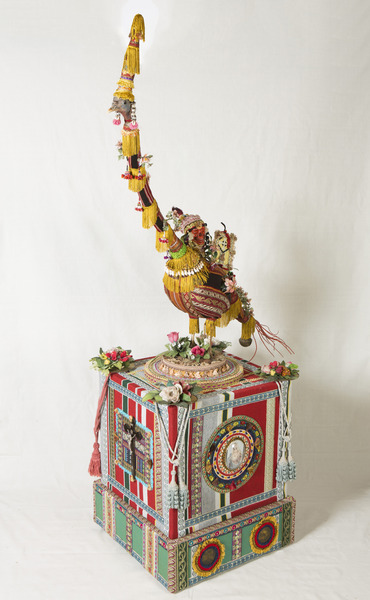For the past twenty years, Benoit Huot has worked in virtual obscurity in Montivernage, a tiny village in France’s eastern Franche-Comté region. The artist’s first exhibition came just this past fall when, at the age of forty-six, a sampling of his sculpture—fifteen whimsically festooned taxidermied animals—was shown in Paris at La Maison Rouge (collector Antoine de Galbert’s foundation.) Soon after this high-profile debut, Huot was picked up by Galerie Eva Hober, where seven new sculptures are currently on view.
Huot’s latest bestial creations (all 2013) are more elaborately conceived and less homogenous in terms of presentation, scale, and animal-type than his earlier work. Instead of wall-mounted heads and trophy animals on white pedestals, Huot’s current exhibition is a menagerie of lifeless, but lavishly garbed, animals including a St. Bernard, a wild boar, a lamb, and a buzzard, all reposed regally on custom-designed platforms. One of the quirkiest stuffed animals is a turkey whose impossibly long neck is fully extended and tightly wrapped in red-and-white striped fabric adorned with alternating bands of gold fringe and fake flower garlands (La roue du soir, 2013). In addition to wearing dangly earrings and a vertiginous fringed hat, the bird’s entire body is swathed in materials of varied sheens and patterns. On the turkey’s back, a pink human skull sporting an elaborate headdress sits next to a framed Celtic cross. Multiple crucifixes and a round miniature painting of a Christian saint grace the sculpture’s sizeable bi-level base—more of a throne or altar, really—which is also brocade covered, tassel laden, and otherwise bedazzled.

Benoit Huot, La roue du soir (dinde), 2013 Techniques mixtes 230 x 180 x 65cm; Courtesy Galerie Eva Hober, Paris; ©Y.Petit
Though the idea of gussied-up dead animals reeks of kitsch, Huot’s work actually comes across as quite earnest. The fastidious craftsmanship of his fetish objects shows a profound respect for the animals as well as his own creative process. Unlike other contemporary artists who have used taxidermy (Adel Abdessemed and Huang Yong Ping come to mind, both having exhibited stuffed animals in Paris in 2012—at the Centre Pompidou and Galerie Kamel Mennour, respectively), Huot’s work is neither political nor abject. Whereas Abdessemed’s fire-blackened assemblages of wolves and foxes and Yong Ping’s decapitated polar bears and tigers with bright-red neck stumps are grisly and provocative statements, Huot’s sculptures are reverential portraits. In interviews Huot has attributed the inspiration to bring new life to animals through art to early experiments with desiccated rodents (and even a mummified cat) he discovered during a home renovation. Though the artist now sources animals on the Internet, a palpable sense of intimacy between the artist and the natural world remains.
Not much of a traveler, Huot collects decorative materials at flea markets, sewing stores, and bric-a-brac shops in France. His treasure trove of accoutrements, however, spans across oceans, eras, and creeds. Asian ribbons are interwoven with cloth dolls from South America and braided locks of human hair are juxtaposed with framed paintings of Jesus. Removed from their original context, ceremonial artifacts take on new meaning when sprinkled amidst curiosities like a plaster tooth mold or a pair of resin-set petrified frogs. Without showing allegiance to any particular religious faith or cultural customs, Huot’s hodgepodge devotional décor is both naïve and utopian.
(Image: Benoit Huot, installation view -TRANSHUMANCES; Courtesy of the artist and Galerie Eva Hober.)